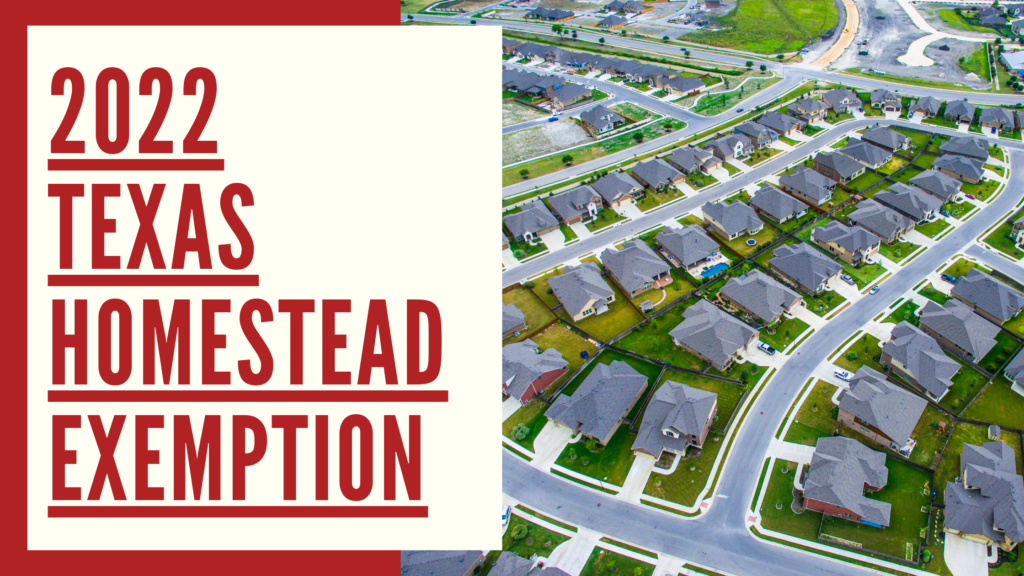
Important Information Regarding the Residence Homestead Application for 2022
There is no fee for filing a Residence Homestead exemption application. There is no need to reapply annually unless that chief appraiser sends you a new application. The general qualifications for the Residence Homestead exemption include the following:
- You must complete the application and provide any additional supporting documents as required by the Texas Property Tax Code.
- You must include a copy of your Texas driver’s license or Personal Identification Certificate. The mailing address must match the address of the property you are applying for.
NEW TO THIS YEAR – the deadline for occupying a property and filing your homestead exemption is (for this year) extended to April 15th, 2022. Per legislature – “A person who acquires property after January 1 of a tax year may receive an exemption authorized by Section 11.13, other than an exemption authorized by Section 11.13 (c) or (d), for the applicable portion of that tax year immediately on qualification for the exemption if the preceding owner did not receive the same exemption for that tax year.” What this means is that you can still file a homestead exemption even if you didn’t acquire the home in 2021.
To receive a Homestead Exemption for the taxes on your home, you must first qualify as a residence homestead on January 1 of the year to which you are applying. Texas offers a variety of partial or total (absolute) exemptions from appraised property values used to determine local taxes. A partial exemption removes a percentage or fixed dollar amount of the property’s value from taxation. A total (absolute) exemption excludes the entire property from taxation. Taxing units are mandated by the state to offer certain (mandatory) exemptions and have the option to decide locally on whether or not to offer others.
There are several types of homestead exemptions available including a general residence homestead exemption, exemptions for people over the age of 65, people and veterans with disabilities, and surviving spouses of service members or first responders killed in the line of duty. A property owner must own and occupy a property to be eligible for a homestead exemption.
What is a Residence Homestead Exemption?
A residence homestead exemption removes a portion of or the total amount of a property’s value from taxation for property tax purposes. Texas offers a variety of partial or total (absolute) exemptions from appraised property values used to determine local taxes. A partial exemption removes a percentage or fixed dollar amount of the property’s value from taxation. A total (absolute) exemption excludes the entire property from taxation.
Taxing units are mandated by the state to offer certain (mandatory) exemptions and have the option to decide locally on whether or not to offer others. To receive a Homestead Exemption for the taxes on your home, your home must first qualify as a residence homestead on January 1 of the year in which you are applying. The deadline for application is April 30th.
Residence Homestead Exemptions Frequently Asked Questions (FAQ)
1. DO I, AS A HOMEOWNER, GET A TAX BREAK FROM PROPERTY TAXES?
You may apply for homestead exemptions on your principal residence. Homestead exemptions remove part of your home’s value from taxation, so they lower your taxes.
For example, your home is appraised at $100,000, and you qualify for a $25,000 exemption (this is the amount mandated for school districts), you will pay school taxes on the home as if it was worth only $75,000. Taxing units have the option to offer a separate exemption of up to 20 percent of the total value.
2. DO ALL HOMES QUALIFY FOR HOMESTEAD EXEMPTIONS?
No, only a homeowner’s principal residence qualifies. To qualify, a home must meet the definition of a residence homestead: The home’s owner must be an individual (for example, not a corporation or other business entity) and use the home as his or her principal residence on January 1 of the tax year. If you are age 65 or older, or disabled, the January 1 ownership and residency are not required for the age 65 or disabled homestead exemption.
3. WHAT IS A HOMESTEAD?
A homestead can be a separate structure, condominium or a manufactured home located on owned or leased land, as long as the individual living in the home owns it. A homestead can include up to 20 acres if the land is owned by the homeowner and used for a purpose related to the residential use of the homestead.

4. WHAT HOMESTEAD EXEMPTIONS ARE AVAILABLE?’
There are several types of exemptions you may receive.
4.1. School taxes.
All residence homestead owners are allowed a $25,000 homestead exemption from their home’s value for school taxes.
4.2. County taxes.
If a county collects a special tax for farm-to-market roads or flood control, a residence homestead is allowed to receive a $3,000 exemption for this tax. If the county grants an optional exemption for homeowners age 65 or older or disabled, the owners will receive only the local-option exemption.
4.3. Age 65 or older and disabled exemptions.
Individuals over 65 or disabled residence homestead owners qualify for a $10,000 homestead exemption for school taxes, in addition to the $25,000 exemption for all homeowners. If the owner qualifies for both the $10,000 exemption for age 65 or older homeowners and the $10,000 exemption for disabled homeowners, the owner must choose one or the other for school taxes. The owner cannot receive both exemptions.
4.4. Optional percentage exemptions.
Any taxing unit, including a city, county, school, or special district, may offer an exemption of up to 20 percent of a home’s value. But, no matter what the percentage is, the amount of an optional exemption cannot be less than $5,000. Each taxing unit decides if it will offer the exemption and at what percentage. This percentage exemption is added to any other home exemption for which an owner qualifies. The taxing unit must decide before July 1 of the tax year to offer this exemption.
4.5. Optional age 65 or older or disabled exemptions.
Any taxing unit may offer an additional exemption amount of at least $3,000 for taxpayers age 65 or older and/or disabled.
5. HOW DO I GET A GENERAL $25,000 HOMESTEAD EXEMPTION?
You may file an Application for Residential Homestead Exemption (PDF) with your appraisal district for the $25,000 homestead exemption up to two years after the taxes on the homestead are due. Once you receive the exemption, you do not need to reapply unless the chief appraiser sends you a new application. In that case, you must file the new application. If you should move or your qualification ends, you must inform the appraisal district in writing before the next May 1st. A list of appraisal district addresses and phone numbers is available online.
6. WHAT IS THE DEADLINE FOR FILING FOR A HOMESTEAD EXEMPTION?
You may file for any homestead exemption up to two years after the delinquency date. The delinquency date is normally February 1st.
7. MAY I CONTINUE TO RECEIVE THE RESIDENCE HOMESTEAD EXEMPTION ON MY HOME IF I MOVE AWAY TEMPORARILY?
If you temporarily move away from your home, you may continue to receive the exemption if you do not establish a principal residence elsewhere, you intend to return to the home, and you are away less than two years. You may continue to receive the exemption if you do not occupy the residence for more than two years only if you are in military service serving inside or outside of the United States or live in a facility providing services related to health, infirmity or aging.
8. IF I OWN ONLY 50 PERCENT OF THE HOME I LIVE IN, DO I QUALIFY FOR THE RESIDENCE HOMESTEAD EXEMPTION ON THE HOME?
Yes. However, if you qualify for a homestead exemption and are not the sole owner of the property to which the homestead exemption applies, the exemption you receive is based on the interest you own. For example, if you own a 50 percent interest in a homestead, you will receive only one-half, or $12,500, of a $25,000 homestead offered by a school district.
Homestead Exemption Required Documents
Here are steps on how to file for your homestead exemption in Texas. First, fill out the application specific to your County Appraisal District, then mail all of the documents to the Appraisal District for your County.
1. FILL OUT THE RESIDENTIAL HOMESTEAD EXEMPTION APPLICATION FOR YOUR COUNTY
DOWNLOAD RESIDENCE HOMESTEAD FORMS
Travis County – https://traviscad.org/homesteadexemptions
Williamson County – https://www.wcad.org/online-exemption-information/
Hays County – https://forms.hayscad.com/#/home
2. INCLUDE A COPY OF YOUR DRIVER’S LICENSE OR IDENTIFICATION CARD
Your driver’s license needs to be from the Texas Department of Public Safety (TX DPS), and the address must match the homestead address.
For manufactured homeowners, you must also provide one of the following:
- A copy of the Texas Department of Housing and Community Affairs statement of ownership.
- Copy of the sales purchase agreement, other applicable contract or agreement, or payment receipt.
- A sworn affidavit (Form 50-114-A) indicating that you are the owner of the manufactured home and the seller did not provide you with the applicable contract or agreement.
Resources:
1. Austin Title





